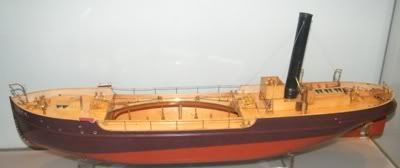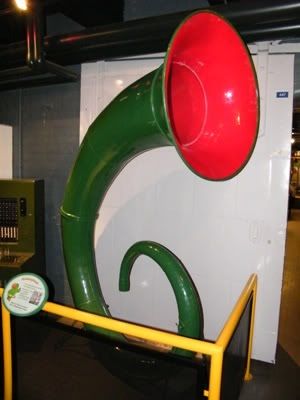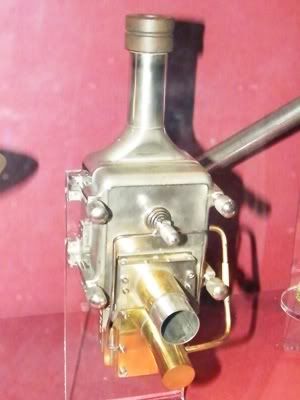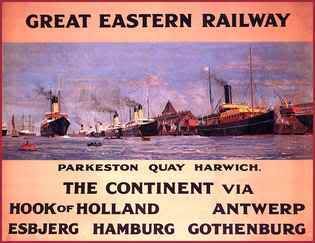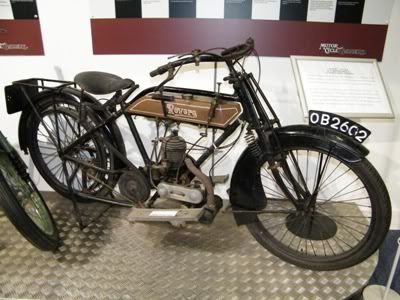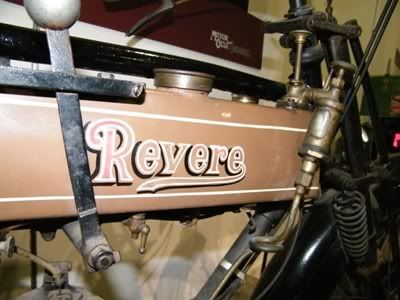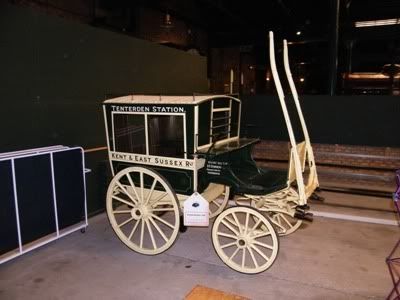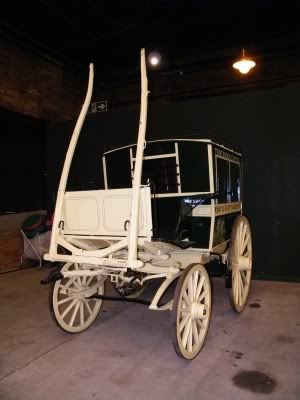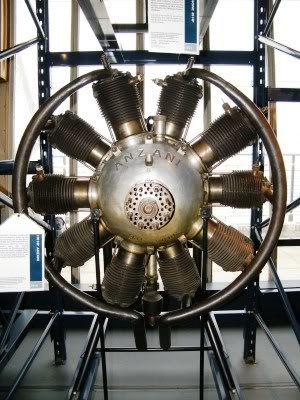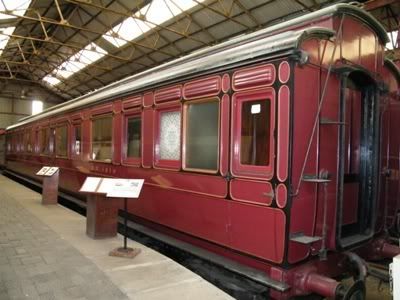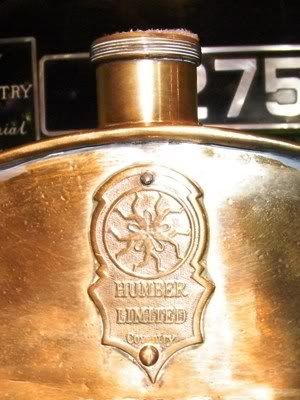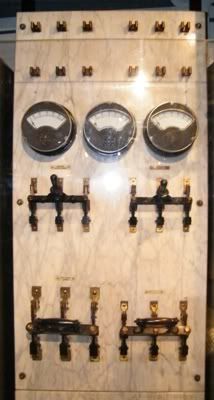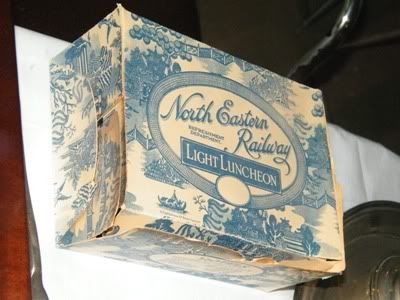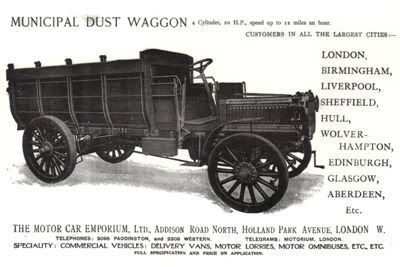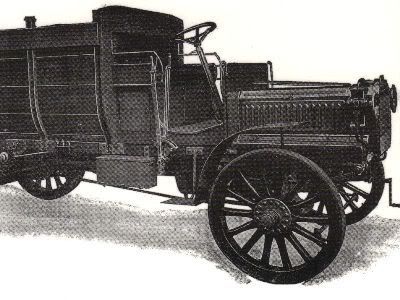A blog about the Edwardian era in the UK - objects, buildings, people, literature, film and all other aspects of the Edwardian era (covering 1901-1919)

Saturday 30 June 2012
North Eastern Railway Bridge Sign, c1903
This sign, commonly seen on most railway bridges in the UK, were known as 'Bridge Diamonds'. They specified the maximum weight for road vehicles that were able to cross the railway bridge they were affixed to, and were updated for the Motor Car Act of 1903. This lovely example is one made for the North Eastern Railway
Thursday 28 June 2012
Hopper Barge, 1902
This is a scale model of a Hopper Barge, depicting barges TIC 14-17, a series of four hopper barges built by Robert Stephenson and Company for the Tyne Improvement Commission between 1902 and 1910 which took the huge amount of material extracted from the river bed of the Tyne by bucket dredgers and took it out to be dumped at sea
Tuesday 26 June 2012
Auxetophone, 1903
This bizarre device, consisting of a huge horn (above) and a valve (below) was invented by Charles Parsons in Newcastle in 1903, and is an early device for amplifying sound, using air resonance to amplify the noise through the horn.
Sunday 24 June 2012
Watch 'A Day in the Hayfields' - 1904
A great portrait of a hot summers day in rural England in 1904 - hay being cut and collected, children playing in the hay, and then the hay being transported and stored at the farm. This was made by Cecil Hepworth, better known for his 'Rescued by Rover' (1905) which was the first international blockbuster, 'The Dog Outwits the Kidnapper' (1908), which is it's sequel, and the first ever film adaptation of Lewis Carroll's book 'Alice in Wonderland' (1903)
Friday 22 June 2012
Great Eastern Railway Poster, 1911
Great Eastern Railway poster dating from 1911, showing Parkestone Quay, Harwich, advertising passenger ship services to the continent. A reproduction of the poster can be bought from here - http://www.past-reflections.co.uk/Great_Eastern_Railway.html
Wednesday 20 June 2012
Revere 2.5hp Motorcycle, 1915
This rare Revere motorcycle was produced by the Sparkbrook bicycle company in 1915, powered by a 2.5hp 269cc single cylinder two-stroke engine. It was designed by WH Whitehouse, who is believed to have been involved with bicycle manufacturer prior to 1915, and made motorcycles under the Whitehouse name from 1919 to 1920, and still with Sparkbrook under the Revere name until 1922.
Monday 18 June 2012
Horse Drawn Omnibus, 1910
Saturday 16 June 2012
Rowntree's Chocolate, c1900
Enamel sign circa 1900 for Rowntree's Chocolate, a very popular brand of confectionery in the Edwardian era
Thursday 14 June 2012
Anzani 100hp Radial Aero Engine, 1914
Alessandro Anzani produced numerous engine types in the years leading up to the First World War but none achieved real production success. This ten cylinder type was tested extensively at Farnborough, UK in 1914. It is an early example of the two-row air-cooled radial which was to become important in the years after the First World War
Tuesday 12 June 2012
Midland Railway Royal Carriage, 1912
Since Queen Victoria's Reign, there has always been a Royal Train, the tradition continuing to today. This Royal Saloon was built in 1912 by the Midland Railway at Derby, and numbered 1910 as this was the year King George V, for whom the carriage was built for, was coronated. The interior was built by Gillows of Lancaster, including a smoking saloon built of English oak, a main saloon built with Cuban mahogany, and a boudoir made with satinwood.
Sunday 10 June 2012
Humber Tourer, 1910
This five seat Humber Tourer is a good example of an Edwardian Tourer, the most common body fitted to Edwardian cars - large seats at the front and back with leather covered upholstery, and no solid roof, but instead a large canvas hood on wooden and/or metal frames that stretched from the back of the car to the windscreen at the front, sometimes overhanging the windscreen, to give rudimentary protection from the elements. Not only was this cheaper than a proper body, it also saved on weight, and meant you were more visible to others - you had to be well off to buy a car in the Edwardian era, so once you'd spent such a large amount of money on a motor car, wouldn't you want everyone to see you in it?
The wheels on this Humber are fitted with quick-detachable hubs, officially called 'Humber Detachable Wheels', a feature Humber was proud of in a time when punctures and other damage requiring change of tyres and/or wheels were commonplace. The 1910 Humber sales brochure describes how they work;
'Jack up the car, unscrew the caps, pull of the wheel, push up the spare one,
screw up the cap, lower car off the jacks and the operation is complete. This
work can be done in three minutes from when the car stops till under way again'
Saturday 9 June 2012
Electrical Switchboard, 1912
This electrical switchboard was made by JH Holmes & Co of Shieldfield, Newcastle in 1912. It was one of four that controlled the electrical circuits at a large shipyard office building. The distinctive finish of marble was used as it is a good electrical insulator.
Thursday 7 June 2012
Electromobile Landaulette (Lambert & Butler Motors 2 of 25)
This is 2 of 25 in Lambert & Butlers Motors series of Cigarette Cards, issued in 1908. From the back of the card;
"These carriages, which are manufactured by the Electromobile Co., Ltd., are among the best known self-propelled carriages in London. Having special advantages for town work, and having the entry to the royal parks during the London season. Electric carriages have during the last few years largely increased in numbers"
Tuesday 5 June 2012
North Eastern Railway Luncheon Box, 1910
Sunday 3 June 2012
Reeves Pneumatic Broom, 1913
The Reeves Pneumatic Broom is an early version of what is now known as the vacuum cleaner or 'Hoover'. It's a very simple device - basically you use the pump handle at the top to pump air up and down, sucking dirt etc up. Very labour intensive, but also very, very simple. This nice example is in the Newcastle Discovery Museum
Saturday 2 June 2012
Watch 'Alice in Wonderland', 1903
Restored in 2010 by the British Film Institute, who have very kindly uploaded it to youtube, this is the first ever film adaptation of 'Alice in Wonderland' by Lewis Carroll, restored from heavily damaged surviving material. It originally ran to twelve minutes, but only eight have survived, and this 1903 version by Cecil Hepworth of the famous story can be seen below
Friday 1 June 2012
Municipal Dust Waggon, c1907
This is a period advert from The Motor Car Emporium Ltd, of Addison Road North, Holland Park Avenue, London. The Motor Car Emporium was a dealer in Durkopp and de Dion Bouton vehicles, specialising in commercial vehicles. This advert shows a 'Municipal Dust Waggon', which would nowadays be known as a dustbin lorry, and although I can't tell for certain I believe it to be a de Dion Bouton chassis. The Dust Waggon boasts a 4 cylinder 20hp engine, with a speed of up to 12 miles per hour. Dust Waggons like this were supplied by The Motor Car Emporium to London, Birmingham, Liverpool, Sheffield, Hull, Wolverhampton, Edinburgh, Glasgow, Aberdeen and others.
Subscribe to:
Posts (Atom)

